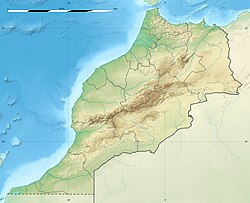The 2004 Al Hoceima earthquake occurred on 24 February at 02:27:47 local time near the coast of northern Morocco. The strike-slip earthquake measured 6.3 on the moment magnitude scale and had a maximum perceived intensity of IX (Violent) on the Mercalli intensity scale. Between 628 and 631 people were killed, 926 injured, and up to 15,000 people were rendered homeless in the Al Hoceima-Imzourene-Beni Abdallah area.
 | |
| UTC time | 2004-02-24 02:27:47 |
|---|---|
| ISC event | 7254476 |
| USGS-ANSS | ComCat |
| Local date | 24 February 2004 |
| Local time | 02:27:47 |
| Magnitude | 6.3 Mw[1] |
| Depth | 12.2 km (7.6 mi)[1] |
| Epicenter | 35°14′N 4°01′W / 35.23°N 4.02°W[1] |
| Type | Strike-slip[2] |
| Areas affected | Morocco |
| Max. intensity | MMI IX (Violent)[2] |
| Peak acceleration | 0.24 g[2] |
| Casualties | 628–631 dead[3] 926 injured[3] 12,539–15,000 displaced[3] |
Earthquake
editThis section needs additional citations for verification. (April 2022) |
The moment tensor and pattern of surface cracks indicate left-lateral strike-slip faulting on a buried NE-SW trending fault.
This earthquake occurred near the epicenter of the magnitude 6.0 Al Hoceima earthquake of May 26, 1994, that had injured one person and caused significant damage to buildings.[4]
Damage
editGround cracks and landslides were observed between Ajdir and Beni Abdallah and maximum peak ground acceleration of 0.24g was recorded near Imzourene. Many fatalities occurred in Al Hoceima, a coastal city along the Mediterranean Sea. Mohammed Boudra, the mayor of Al Hoceima, said most of the casualties were women and children. Further inland, many more residents of scattered villages within the Rif Mountains died. The mud houses of Tazaghin, Tizi Ayash and Imzourn, villages on the mountain, were damaged. The village of Ait Kamara was also "completely destroyed".[4]
Aftershocks
editSeveral aftershocks killed at least three people and destroyed previously weakened buildings. This earthquake occurred near the eastern end of the Rif mountain belt, which is part of the diffuse boundary between the African and Eurasian plates.
See also
editReferences
edit- ^ a b c ISC (2015), ISC-GEM Global Instrumental Earthquake Catalogue (1900–2009), Version 2.0, International Seismological Centre
- ^ a b c "M6.4 – Strait of Gibraltar". United States Geological Survey.
- ^ a b c PAGER-CAT Earthquake Catalog, Version 2008_06.1, United States Geological Survey, September 4, 2009, archived from the original on 2020-03-13
- ^ a b Goodman, Al (February 25, 2004). "Over 500 killed in Morocco quake". CNN. Archived from the original on July 13, 2012. Retrieved October 28, 2013.
Further reading
edit- Akoglu, A. M.; Cakir, Z.; Meghraoui, M.; Belabbes, S.; El Alami, S. O.; Ergintav, S.; Akyüz, H. Serdar (2006), "The 1994–2004 Al Hoceima (Morocco) earthquake sequence: Conjugate fault ruptures deduced from InSAR" (PDF), Earth and Planetary Science Letters, 252 (3–4): 467–480, Bibcode:2006E&PSL.252..467A, doi:10.1016/j.epsl.2006.10.010
- Cakir, Z.; Meghraoui, M.; Akoglu, A. M.; Jabour, N.; Belabbes, S.; Ait-Brahim, L. (2006), "Surface Deformation Associated with the Mw 6.4, 24 February 2004 Al Hoceima, Morocco, Earthquake Deduced from InSAR: Implications for the Active Tectonics along North Africa", Bulletin of the Seismological Society of America, 96 (1): 59–68, Bibcode:2006BuSSA..96...59C, doi:10.1785/0120050108
- Stich, D.; de Lis Mancilla, F.; Baumont, D.; Morales, J. (2005), "Source analysis of the Mw 6.3 2004 Al Hoceima earthquake (Morocco) using regional apparent source time functions" (PDF), Journal of Geophysical Research, 110 (B06306): 1–13, Bibcode:2005JGRB..110.6306S, doi:10.1029/2004jb003366, archived from the original (PDF) on 2013-10-29, retrieved 2013-10-28
- Telesca, L.; Rouai, M.; Cherkaoui, T. E. (2009), "Time-clustering behavior in the sequence of the aftershocks of the Al-Hoceima (Morocco) 24 February 2004 earthquake", Natural Hazards and Earth System Sciences, 9 (6): 2063–2066, doi:10.5194/nhess-9-2063-2009
External links
edit- M6.4 Al Hoceima, Morocco Earthquake of 24 February 2004 – USGS
- Buried Strike Slip Faults: The 1994 and 2004 Al Hoceima, Morocco Earthquakes
- Moroccan Seismic Network: Overview – IRIS Consortium
- The seismic design code for buildings: A priority for seismic risk reduction in Morocco
- Preliminary Observations on the Al Hoceima, Morocco, Earthquake of February 24, 2004 – EERI
- Al-Hoceima earthquake 24 02 2004 – Patrick Murphy Corella
- Earthquake Mw 6.5 in Morocco, February 24th, 2004 – EMSC
- The International Seismological Centre has a bibliography and/or authoritative data for this event.
- ReliefWeb's main page for this event.
